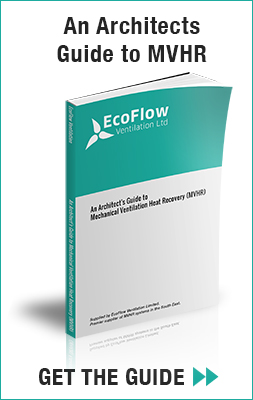What you should consider when installing an MVHR system
Whole house ventilation has been available for a while, but recent years have seen some dramatic improvements compared to early MVHR systems. What do you need to consider if you’re going to install an MVHR system yourself? Here are just some of the things you need to bear in mind when fitting a modern mechanical ventilation heat recovery system.
Work with an expert from the offset
You could leave it until later. Some people do. But it makes much more sense to work with an expert right from the start, from the building design process upwards. It means the MVHR design is considered along with the joist frames, water and heating pipes, which also need to be fitted together in the void space.
Meeting ventilation targets with the right ducting
You need to meet certain ventilation rates, and manufacturers recommend rigid ducting for the majority of your installation. You need to minimise the number of bends in the ducting and make sure it takes the path of least resistance. This means picking the right ducting for the job, and being especially careful with rectangular flat ducting.
Flexible ducting isn’t recommended since it’s highly resistive, can be crushed so easily and isn’t made to last. In fact the building regulations say you shouldn’t use any more than 300mm flexible duct per leg .
What about the connecting ductwork? You need to prevent air leaks, so when joining two pieces of duct together it’s vital to follow the system manufacturer’s guidelines and use the products they recommend.
Controlling condensation and moisture
Condensation occurs when warm, humid air is extracted from bathrooms, showers, kitchens and utility rooms and comes into contact with the cooler surface of a ventilation duct. If the air extracted is
significantly cooled the moisture will condense into water. When it gets trapped in the ducting, all hell can let loose with a damaged fan and even potential damage to the fabric of the building itself.
This is why building regulations insist on horizontal ducting, including the ducting in the walls, being fitted so it slopes very slightly downwards away from the fan to prevent moisture flowing back into the fan unit itself. At the same time ducting that rises vertically to take extracted air outdoors must have a condensate trap fitted to prevent moisture dropping back down and into the fan unit. And you also need to connect to a soil vent using 21.5mm pipe.
What about the insulation side of things?
When ducting passes through an unheated or chilly space like your loft when carrying cold air between
the external supply and the discharge terminals, the rules say it has to be insulated. This stops condensation forming on the outside of the duct, which protects the ceiling from moisture damage and also improves the entire system’s efficiency.
It goes without saying that it’s vital to read the manufacturer’s Installation and Maintenance Manual
before you start, not least because every different type of MVHR unit comes with its own unique installation requirements to help you make the most of the system.
The all-important condensate drain
You must install a condensate drain from the fan, with a minimum 5 degree fall from the MVHR unit. And if it’s in an unheated space, it’s vital to insulate the space to prevent freezing.
Mandatory manual boost switches in wet areas
So-called wet areas like kitchens, bathrooms, en-suites and utility rooms should have manual boost switches within reasonable reach, otherwise your system won’t comply with the regulations. The rules also say that people should not be able to turn off the fan for continuous ventilation systems unless it’s via the local isolator… which means it’s essential to use a qualified electrician.
Minimising noise from the beginning of the design process
Once MVHR is installed it can cost a lot of time, hassle and cash to get noise issues fixed. It’s vital to use a professional MVHR system design service like ours, which delivers a full acoustic analysis. It’s also important to make sure your installation follows best practice as regards avoiding extra resistance, which can generate unexpected, unwanted noise after commissioning.
Using the right kit
When installing MVHR it’s really important to use air valves, grilles and tiles that have been specifically designed for the purpose. There are several vital guidelines to follow to make sure the air valves are balanced, external grilles are installed the right distance apart and the tile vent or roof cowl avoids resistance.
MVHR compliance – the evidence
Building Control demands you fill in an inspection check-list and airflow measurement test sheet, which comes in three parts:
- Recording the system details including the installation address and installer details
- An installation check-list and 2b, a record of the visual inspection results, which acts as a pre-test check-list
- Recording the system commissioning process
A bit about MVHR system commissioning
Commissioning is just as important as design and installation. And there’s an official approved procedure to follow including air flow readings, reported in a special way within a strict time period. If you have issues on site and your MVHR system design needs changing, you must go back to the manufacturer and make sure the new design still meets the building regulations.
You can DIY… but it’s better with a pro!
While you can do a DIY job, MVHR manufacturers and other experts all recommend you use a professional to design, specify, fit and commission your system. Like any such system, whether it’s bog standard central heating or something more complex and unusual, getting it right first time can save you an awful lot of time, hassle and expense.





Leave A Comment